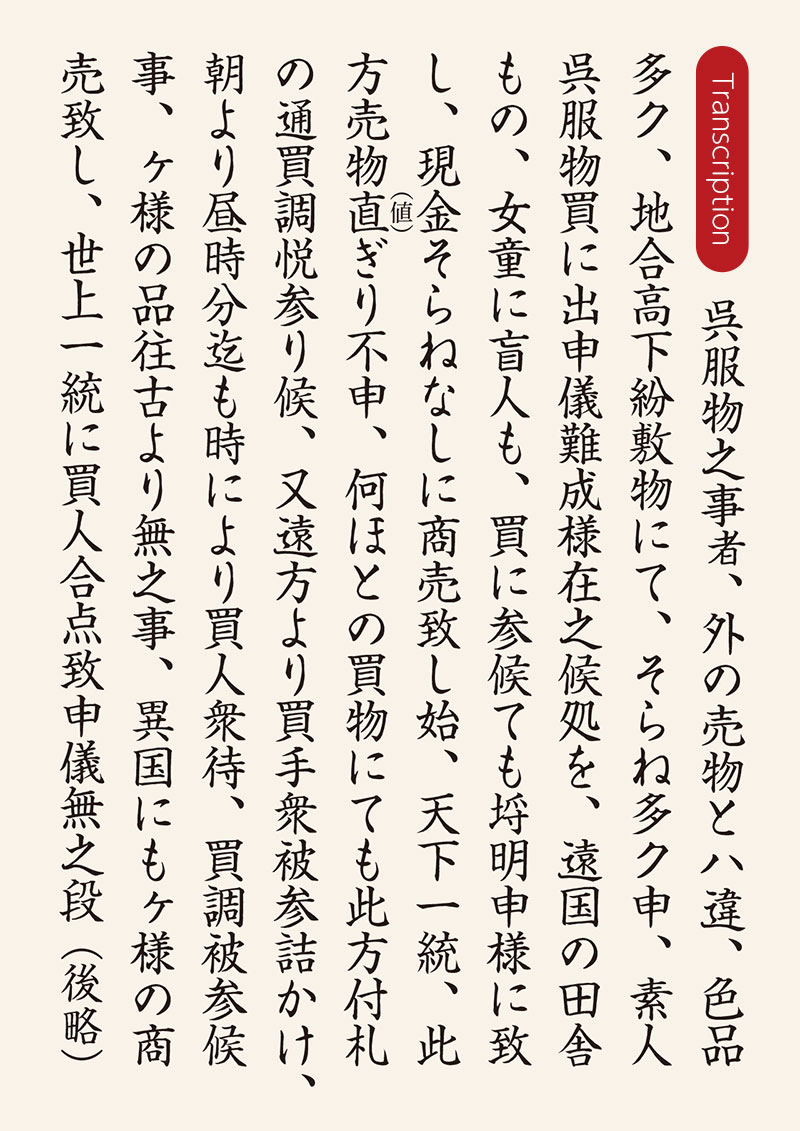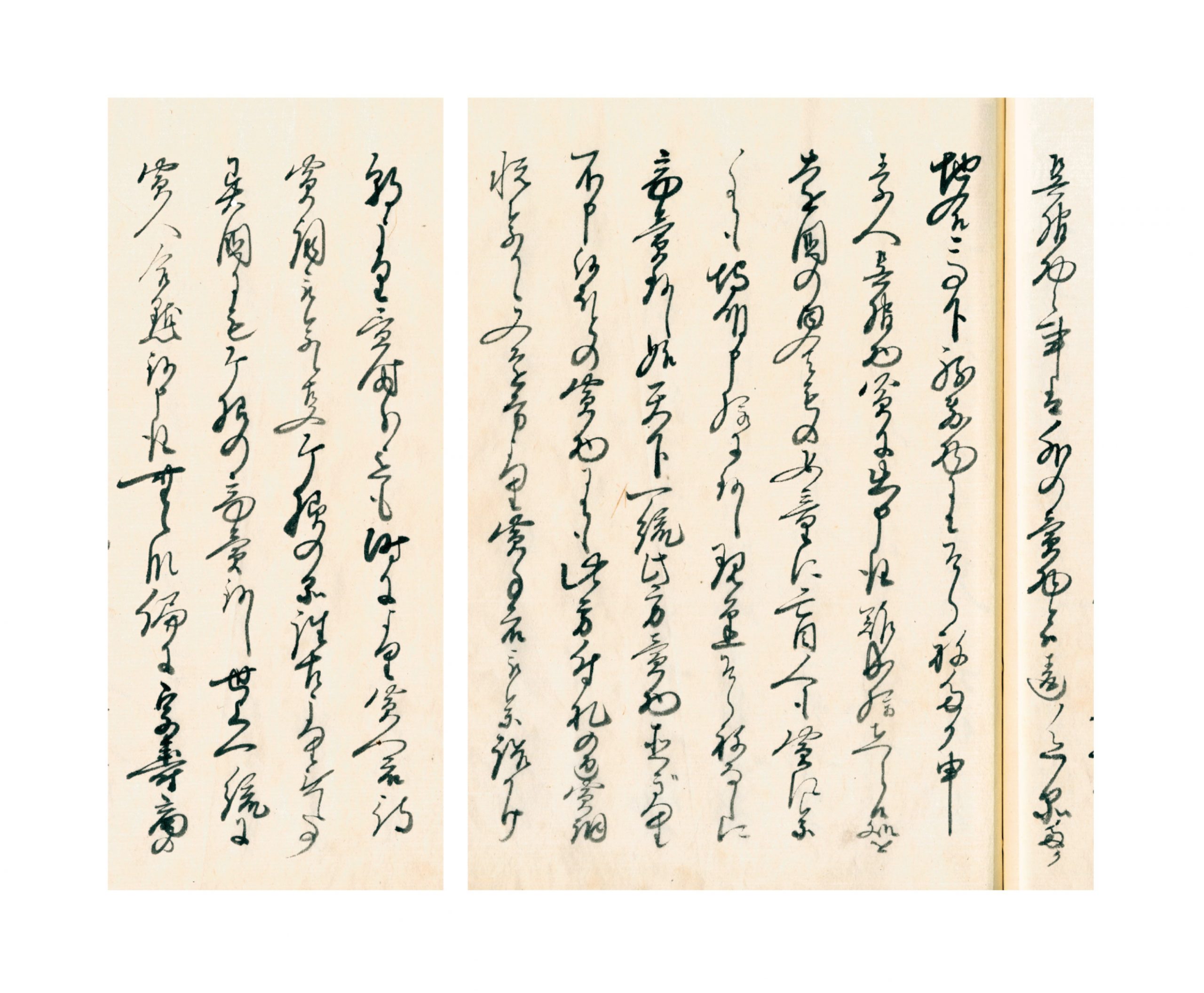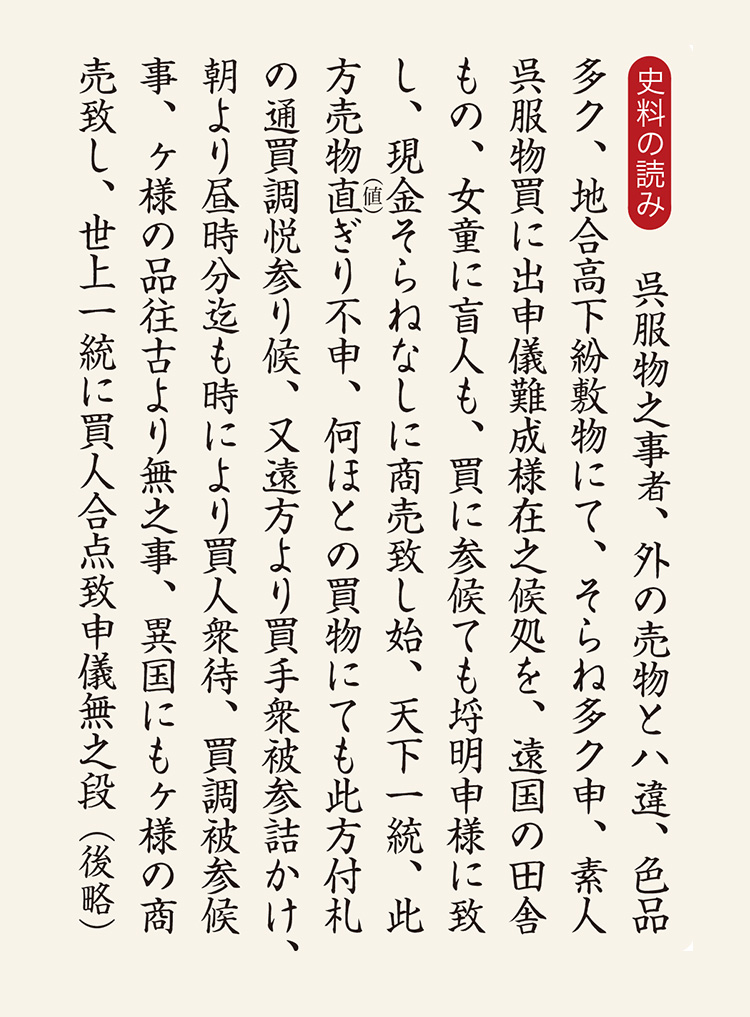04 Genkin Kakene Nashi
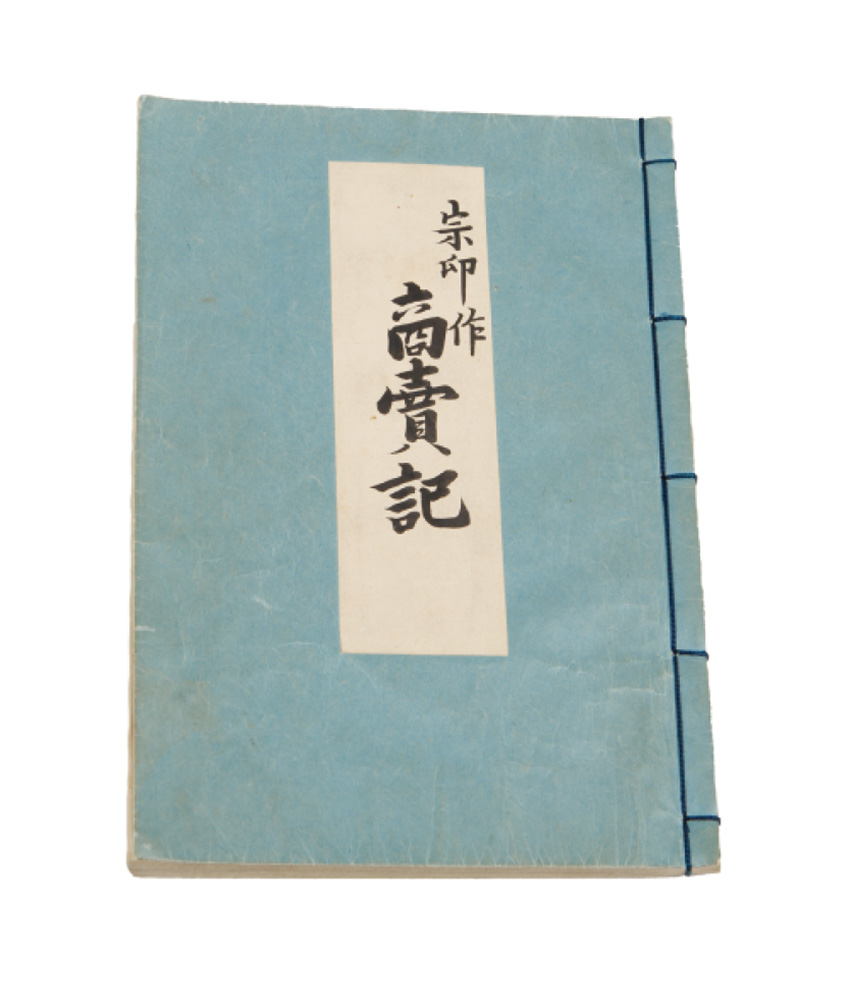
Mitsui’s Shop Sign Phrase
The catchphrase most associated with Mitsui in the early modern period was its highly successful slogan of, genkin kakene nashi (cash basis at fixed prices). This was widely known from that same period due to having been written on advertising flyers(hikifuda [leaflets], →14) and on shop signs using the painting favored by later generations (→Fig. 04b). This commercial practice was recognized throughout the early modern era as the cornerstone of Mitsui’s business.
The Meaning of Genkin Kakene Nashi
According to Shobaiki (→Fig. 04a), fair values for kimono fabric were difficult to ascertain and persons who lacked knowledge and bargaining skills found them difficult to purchase. It claims that this led the company to introduce a system where all customers could make their purchases at the same price, and it proved to be great success. The sale of kimono fabric up to that point in time involved such methods as yashiki-uri (house sales) or kake-uri (credit sales). These entailed the seller forming stable relationships with wealthy customers such as samurai, bringing goods to their estates, negotiating each time to decide on a price, and then having the payments combined into a lump sum at the end of a specified period. Neither Takatoshi father nor son had such customers at the start. They introduced in-store sales as had been practiced by Izu-kura-a related Matsusaka merchant-and, using the device of cash payments-made innumerable customers their partners. Furthermore, they remedied the practice of making price increases premised by bargaining for discounts by fixing prices, which made it possible for customers unfamiliar with kimono fabrics to accept the prices and make purchases.
Growing in Edo
The new commercial practices of Takatoshi father and son were ones that cleverly responded to changes in the market. As the new center for politics, the population of Edo was rapidly growing. Enormous demand was being created for haute couture item that was kimono fabric. It is thought that with the population of Edo growing rapidly, Takatoshi’s commercial practices were a way to cleverly gain as customers those persons who, while they had gained high status and incomes, still lacked knowledge about kimono fabrics or had no established business relationships.
New Commercial Practices
Shobaiki contains mention of the language (→01) that Takatoshi used to promote his new commercial practices and some of the various innovations he actually used. For example, while it was common practice for other merchants to lay in a set amount of stock every year like clockwork, Takatoshi would lay in a large amount of stock if the cost was inexpensive regardless of what orders he had in Edo. He then carefully adjusted his selling prices in Edo based on that cost and drove forward with a low-margin, high-turnover business.
His second-oldest son Takatomi (→06) also conceived a variety of new commercial practice innovations, and Riemon-who had been employee ever since the opening of the Edo shop-likewise came up with various innovations in doing business such as being to work with kimono fabric dealers from various locations.
Enormous Success
Takatoshi and his sons became very successful in short period of time, and sales in the 10 years since opening the Edo shop grew fivefold.
That success was a spectacular thing. Even as early as 1688, the great writer Ihara Saikaku in one of his works featured a merchant modeled on Takatoshi and sang his praises (→01). The writer introduced his commercial practices, such as putting a specialist in charge for each type of product, selling fabrics by the piece, and tailoring haori and other garments on the spot.
The conspicuous success of Takatoshi and his sons invited a fierce backlash from his fellow tradesmen, while the Kishu Tokugawa family-lords of Takatoshi’s hometown of Matsusaka-and both the shogunal family and high-ranking officials in the shogunate began paying attention to Takatoshi.

Written by Takatoshi’s third son, Mitsui Takaharu (→06). Completed in 1722, this book has been handed down in the Kita family, the Mitsui head family. One of the series of records made during the Kyoho era (1716-1736), it describes the business in its founding days as well as Takatoshi’s words and deeds. Also appended are some exhortations from Takaharu himself. Given that Takatoshi’s generation was not interested in preserving documents such as ledgers, this record provides the most detailed picture of the business in those days.
We know that the main aim was to extol Takatoshi’s talent for business and convey this to his descendants, and that there was picking and choosing with regard to selection of what items to record. Still, Takaharu had been on the frontlines of the business under his father Takatoshi’s guidance since his teens, and so the details he recorded are considered to be reliable.
Shobaiki (a record of Mitsui’s founding days)
Translation
Kimono fabric is unlike other products. There are many varieties, the quality of the fabrics is easily mistaken, and lies about prices would often be told (premised by haggling). Buying it was very difficult for the non-professional. We Mitsuis saw this and began dealings in way that made it okay for even persons from the hinterlands, girls, and the visually impaired to come to our shop, with cash payments and no false prices. Everyone from everywhere happily makes their purchases of whatever they are buying at the prices we have set without any haggling over our products. Customers come from far away to pack our shop, and even in the morning at times they wait in line to do their shopping. This kind of thing did not happen in the past. There have been no examples even in foreign countries of winning customer satisfaction through such commercial practices.
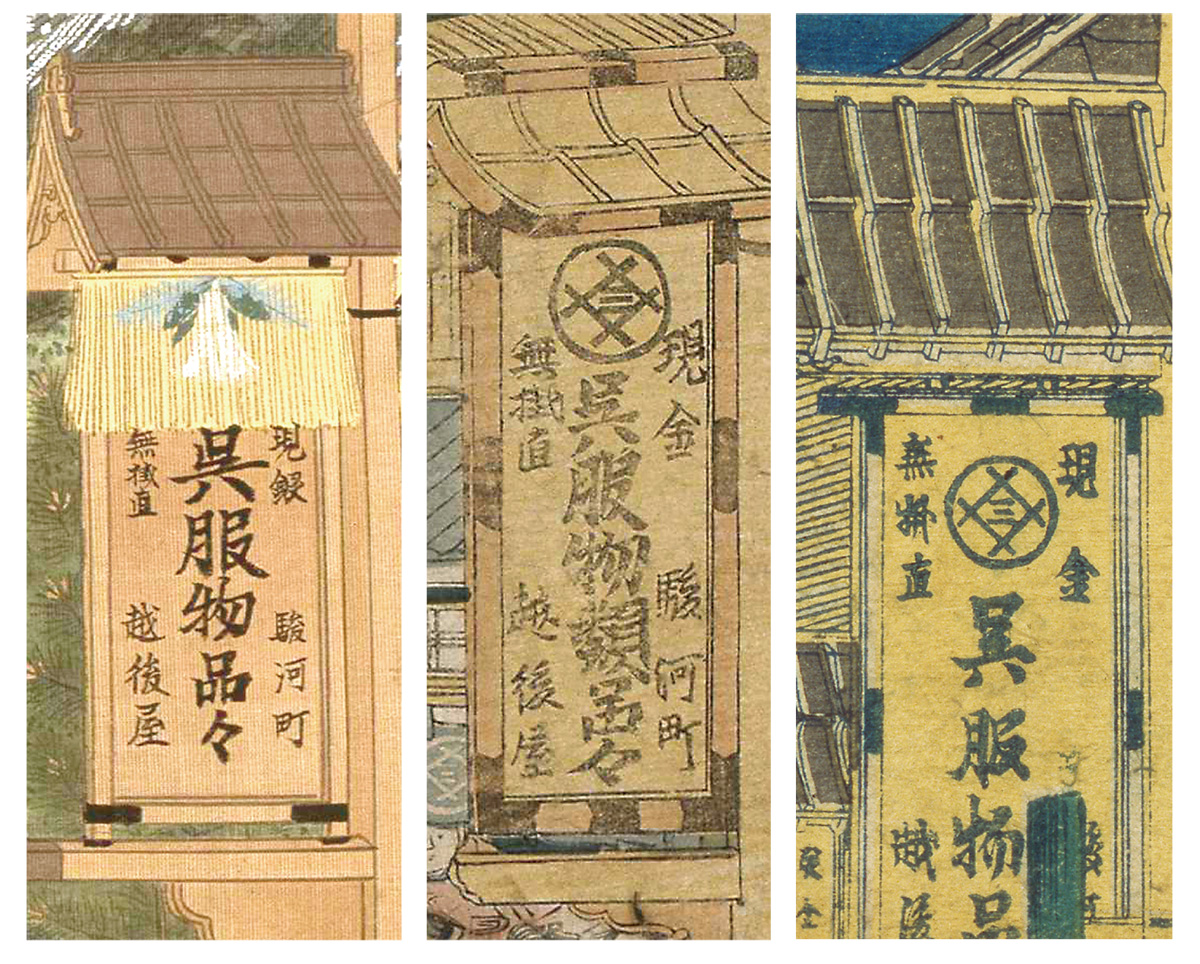
Signage at the Edo kimono shop in Surugacho, as depicted in 19th century woodblock prints. This storefront was a noted place of interest in Edo, and it was depicted in many prints. It can be recognized for the appearance of the phrase, genkin kakene nashi.
Right: Katsushika Hokusai, “Thirty-Six Views of Mount Fuji-Mitsui Shop at Surugacho in Edo” (section).
Center: Kitagawa Utamaro II, “The Echigoya in Surugacho” (section).
Left: Artist unknown, “New Year’s Scene at Surugacho Echigoya” (→03) (section).

